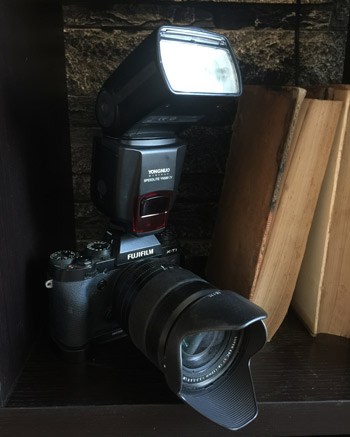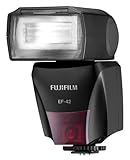
When I look at a new camera system, my first questions are about the lens system and the flash system, and THEN I'll consider the actual camera itself.
The main reason why I avoided the Sony camera system a few years ago (this is no longer an issue) is because their “standard” hotshoe was, well, not standard.
So when I decided to take a hard look at switching to Fuji from my Nikon full-frame camera, the flash system was one of the first things I tested.
I was surprised and relieved to find how well Fuji cameras handle flash systems from other manufacturers, which was a major reason why I ended up making the switch.
All Fuji cameras I have tested use standard hotshoes that are capable of working with third-party flash triggers and speedlights.
That's the good news! But there are some drawbacks to using flash on the Fuji system, which we'll dive into later.
First, let's have a look at the Fuji flash system and see how it compares with the stuff from other major manufacturers, then we'll consider third party flash systems like Phottix, Yongnuo, and others.
In the end, I'll give my conclusion on the best flash system for my Fuji XT1 mirrorless camera.
Fuji's Own Flash System
There isn't much good to say about the Fuji's own flash system except for three things
- It's inexpensive;
- I like the ingenious little pop-up flash on the Fuji XT1;
- And it will make you laugh every time you see a humungous Speedlight mounted to the hotshoe of a tiny little mirrorless camera.
It looks like a sumo wrestler riding on a goat.
Fuji produces four speedlights, but only one of them has any real use for anything other than simple on-camera flash: the Fujifilm EF-42 Speedlight flash.
The funny thing about that (two funny things in one article, whew!), is that Fuji didn't even produce the Fujifilm EF-42 flash (at time of writing).
It's actually just a Sunpak PZ42X flash with a Fuji logo bolted on it and a higher price tag. That's it.
You'll also notice that Sunpak produces the flash for all of the major camera brands—except Fuji.
Why? Because it DOES produce the flash, just under a different brand name.
So if you really want to have the official Fuji Speedlight on your camera, then do yourself a favor.
Just buy a Sunpak PZ42X and put a piece of electrical tape over the logo so nobody finds out your big secret.
Noticing any “subtle” similarities? It's because the Fuji flash is really just a Sunpak flash with a different logo on it.
Props to Fujifilm for having a better product image.
Sunpak's official image for the flash is a little overexposed and the plastic reflects the light of the flash. Tsk tsk.
Yongnuo Flashes on Fuji Cameras
Yongnuo is my flash of choice for my Fuji XT1.
I've been using Yongnuo flashes since before it was even cool to use Yongnuo flashes.
These little $70 flashes are extremely powerful, simple to use, and have a robust system around them for full feature flash photography.
Yongnuo is a Chinese company that makes inexpensive knock-offs of Canon flashes that are compatible with any brand of camera.
In the Yongnuo lineup, the most popular flash by far is the YN-560 line.
Right now the current model is the YN-560 IV.
This flash is all manual, has a strong power output, is easy to use, and is very reliable.
Reliability is something I really admire about Yongnuo.
The original YN-560 was plagued with issues, but since then the company has made these inexpensive flashes very dependable.
Sometimes it can be a trick to get the settings all right to make a trigger and flash sync together, but I don't think I've ever had a misfire with Yongnuo flashes when I have them set up correctly.
The system works well, and the radio signal can fire from a LONG distance away!
The big question is if you need high-speed sync and ETTL.
While Yongnuo does make speedlights with these features, they don't make any for the Fuji system.
For me, that isn't a limitation at all. High-speed sync seems like a must-have technology in a flash until you actually shoot with it and realize that the power output is so low that it rarely makes sense.
And for me personally, I find ETTL to be significantly more complicated and slow than using manual flash in most situations.
If you want to learn more about why this is, it's really worth the time to read my flash photography basics series of articles.
The Setup I Recommend for Fuji Flash
I'd buy one or two YN-560IV flashes and a YN560TX trigger.
The flashes can be used on the hotshoe of the camera or off the camera by putting the YN560TX on the hotshoe of the camera to trigger the flashes wirelessly.
When you go to buy your YN560IV and the YN560TX trigger, DO NOT WORRY that the listing doesn't specifically say it's for Fuji.
Just go ahead and buy the Nikon version.
I've personally tested it and I promise the Nikon version will work JUST FINE on Fuji.
The links above ARE to the correct models you'll need to get this to work.
If you have any trouble getting your Fuji camera to fire the flash, be sure to check out my YN560 HELP article!
You can get it at this link: https://improvephotography.com/42218/yn560-tutorial/

The Real Problem with Flash Photography on Fuji Cameras
One of my biggest complaints about the Fuji system is the very slow flash sync speed.
The flash sync speed is the fastest shutter speed at which the camera can shoot while still exposing the entire frame with the flash.
The flash sync speed on most fuji cameras is just 1/180, whereas most cameras can go up to 1/200, 1/250, or sometimes even 1/320.
That makes a huge difference for a photographer who wants to use flash in the daylight.
However, one possible solution for this problem is to simply use a neutral density filter.






flash sync on a fuji? i’m pretty sure the xpro 2 and xt series all have HSS. just an FYI.
Very nice article and it actually got me excited to think I can buy a PZ42X and put it on my X100. Alas, not to be true. It is unfortunate that you exclaimed that the EF-42 is the same as the PZ42X when in fact they are not. The key component is not so much the workings of the flash, but the shoe, or the interface between the camera and the flash. They are not the same.
So it is too bad that you wildly stated it was a rebranded PZ42X, and rightly so, but you should have followed up that a PZ42X will not work on an X100 except in manual mode. Then again, there are hundreds of cheaper flashes that will work on the X100 in manual mode. My old Nikon SB16 worked in manual mode.